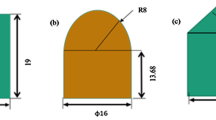Abstract
The thermal protection structure of a spacecraft in service inevitably suffers from hypervelocity impact by space debris. The 2D plain-woven C/SiC composite is a typical ceramic-matrix material that has been extensively applied for thermal protection. In this study, the effects of Mylar flyers on 2D-C/SiC composite and LY12 hard aluminum under the velocity range from 3400 m/s to 9300 m/s are investigated using an electric gun. The free surface velocity history of the specimen is recorded through the Doppler probe system, and the debris clouds are collected using a foam plate. Then, an orthotropic constitutive material model is chosen to describe the hypervelocity impact response of the 2D-C/SiC composite using the commercial software Autodyn. Numerical simulations are conducted based on smooth particle hydrodynamics solver, and the results agree well with the experimental data. The relationships of free surface velocity to the flyer diameter and plate thickness are also discussed. The results from this study are very useful for thermal protection structural design.
Similar content being viewed by others
References
J. Mason et al, Orbital debris-debris collision avoidance, Advances in Space Research, 48 (10) (2011) 1643–1655.
Y. H. Kim, J. H. Yoo and M. Y. Lee, Optimal design of spaced plates under hypervelocity impact, Journal of Mechanical Science and Technology, 26 (5) (2012) 1567–1575.
M. Y. Lee and Y. J. Cho, Characterization of the ballistic limit curve for hypervelocity impact of sphere onto single plate, Journal of Mechanical Science and Technology, 25 (9) (2012) 2457–2463.
R. Naslain, CVI composites, In: Warren R ed. Ceramic-Matrix Composites, Chapman and Hall, London, England (1992) 199–243.
F. Lamouroux, et al., Oxidation-resistant carbon-fiber-reinforced ceramic-matrix composites, Composites Science and Technology, 59 (7) (1999) 1073–1085.
L. T. Zhang, L. F. Cheng and Y. D. Xu. Progress in research work of new CMC-SiC, Aeronautical Manufacturing Technology, 1 (2003) 24–32 (in Chinese).
G. Camus, L. Guillaumat and S. Baste, Development of damage in a 2D woven C/SiC composite under mechanical loading: I. Mechanical characterization, Composites Science and Technology, 56 (12) (1996) 1363–1372.
R. E. Bouazzaoui, S. Baste and G. Camus, Development of damage in a 2D woven C/SiC composite under mechanical loading: II. Ultrasonic characterization, Composites Science and Technology, 56 (12) (1996) 1373–1382.
T. Suo, Y. L. Li and M. S. Liu, Research on mechanical behavior of 2D C/SiC composites at elevated temperature under uniaxial compression, Acta Armamentar II, 34 (4) (2010) 516–520 (in Chinese).
G. Y. Guan, G. Q. Jiao and Z. G. Zhang, In-plane shear fracture characteristics of plain-woven C/SiC composite, Mechanical Science and Technology, 24 (5) (2005) 515–517 (in Chinese).
Z. G. Zhang, Prediction of the elastic constants and failure mode study of 2D-C/SiC composite, Northwestern Polytechnical University, Xi’an, China (2005).
R. A. Clegg et al., Application of a coupled anisotropic material model to high velocity impact of composite textile armour, 18th International Symposium and Exhibition on Ballistics, San Antonio, USA (1999).
C. E. Anderson et al., A constitutive formulation for anisotropic materials suitable for wave propagation computer program-II, Computational Mechanics, 15 (1994) 201–223.
S. Hiermaier et al., Advanced material models for hypervelocity impact simulations, EMI-Report, No. E43/99, ESA CR (P) 4305 (1999).
J. K. Chen, F. A. Allahdadi and C. T. Sun, A quadratic yield function for fiber-reinforced composites, Journal of Composite Materials, 31 (8) (1997) 788–811.
J. P. Hou, N. Petrinic and C. Ruiz, Prediction of impact damage in composite plates, Composites Science and Technology, 60 (2) (2000) 273–281.
Author information
Authors and Affiliations
Corresponding author
Additional information
This paper was presented at the FEOFS 2013, Jeju, Korea, June 9–13, 2013. Recommended by Guest Editor Jung-Il Song
Yang Yang received his B.S. degree in College of Mathematics and Information Science from Shaanxi Normal University, China, in 2008. He then received his M.S. degree in School of Science from Northwestern Polytechnical University in 2010. Dr. Yang is currently a Ph.D. candidate in the School of Aeronautics from Northwestern Polytechnical University, China. Dr. Yang’s research interests include SPH method and impact response of ceramic-matrix composites.
Rights and permissions
About this article
Cite this article
Yang, Y., Xu, F. Experimental and numerical investigation on hypervelocity impact response of 2D plain-woven C/SiC composite. J Mech Sci Technol 29, 11–16 (2015). https://doi.org/10.1007/s12206-014-1202-3
Received:
Revised:
Accepted:
Published:
Issue Date:
DOI: https://doi.org/10.1007/s12206-014-1202-3




